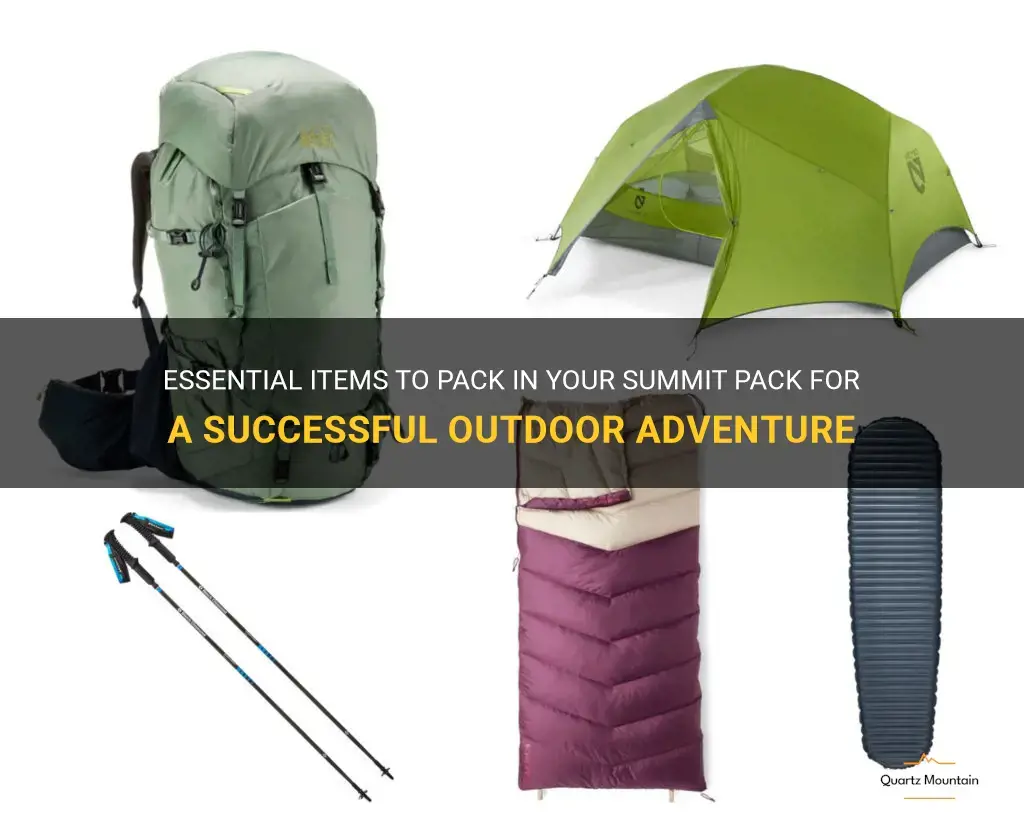
Heading out for an outdoor adventure, whether it's a day hike or a multi-day trek, requires careful planning and preparation. One essential item that should always be on your checklist is a summit pack - a compact backpack that's specifically designed for hiking and mountaineering. Packing the right items in your summit pack can make or break your outdoor experience. In this article, we will explore the essential items that should be packed in your summit pack to ensure a successful and enjoyable adventure in the great outdoors. So, get ready to gear up and conquer new heights!
| Characteristic | Value |
|---|---|
| Size | Small and compact, enough to hold essentials |
| Weight | Lightweight |
| Durability | Durable and able to withstand rough conditions |
| Water Resistance | Waterproof or at least water-resistant |
| Compartments | Multiple compartments or pockets to organize belongings |
| Accessibility | Easy access to items without needing to remove the pack |
| Comfort | Padded straps and back panel for comfortable carrying |
| Ventilation | Breathable materials or mesh panels for air circulation |
| Hydration Sleeve | Built-in or compatible with hydration reservoir |
| Compression | Ability to compress the pack to reduce bulk |
| Attachment Points | Gear loops or straps to attach additional equipment |
| Reflective | Reflective elements for visibility in low light conditions |
| Load Stabilization | Adjustable straps or compression system to stabilize load |
What You'll Learn
- What are the essentials that should be carried in a summit pack for a hiking trip?
- How much water should be carried in a summit pack for a day hike?
- Are there any specific items that should be included in a summit pack for a winter hiking trip?
- What should be considered when selecting a summit pack for a long-distance trek?
- Are there any recommended safety items that should always be included in a summit pack, regardless of the hiking conditions?

What are the essentials that should be carried in a summit pack for a hiking trip?
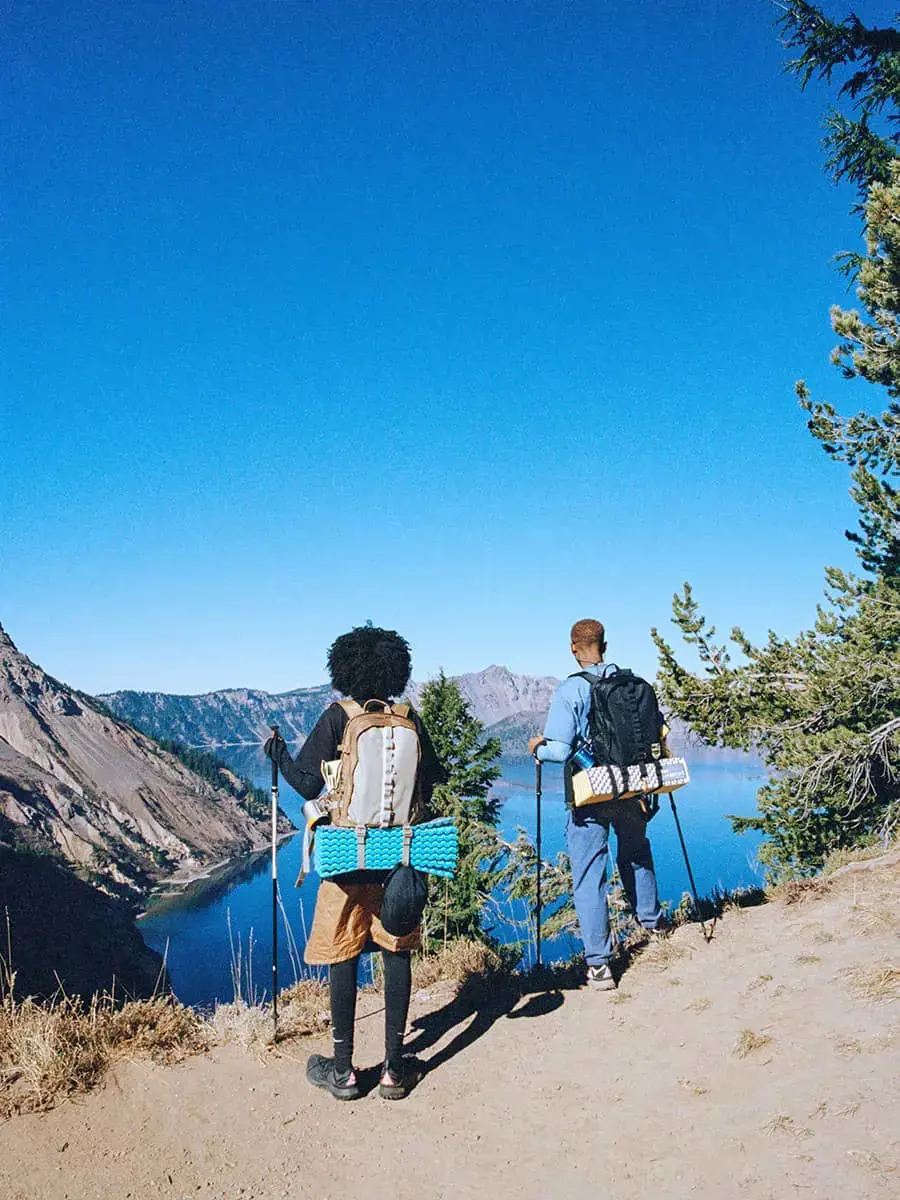
When planning a hiking trip, it is essential to have a summit pack that contains all the necessary items for a successful and safe adventure. A summit pack is a small backpack that is carried during the final ascent to the summit of a mountain or peak. It is important to pack efficiently and only carry the essentials to keep the pack light and manageable. In this article, we will discuss the essentials that should be carried in a summit pack for a hiking trip.
- Water: Staying hydrated is crucial during any physical activity, especially during a challenging hike. It is important to carry enough water to last the duration of the hike, as water sources may not be available along the way. It is recommended to bring a water bottle or hydration bladder that can be easily accessed during the hike.
- Snacks: Hiking requires a significant amount of energy, so it is important to pack snacks that can provide a quick source of fuel. Nutritious snacks such as energy bars, trail mix, and dried fruit are lightweight and easy to carry. These snacks not only provide energy but also help to prevent fatigue and keep you going throughout the hike.
- Navigation Tools: It is essential to have navigation tools such as a map, compass, or GPS device to help you navigate through the trail. These tools will ensure that you stay on the right path and avoid getting lost. It is also a good idea to carry a whistle and a signaling mirror in case of emergencies.
- First Aid Kit: Accidents can happen during a hike, so it is important to carry a basic first aid kit. The kit should include items such as adhesive bandages, sterile gauze, antiseptic wipes, adhesive tape, pain relievers, and any personal medications you may need. It is also important to have knowledge of basic first aid procedures.
- Extra Clothing: Weather conditions can change rapidly in the mountains, so it is important to be prepared for any changes in temperature or weather. Packing a lightweight and waterproof jacket, hat, gloves, and extra socks can help you stay warm and dry. It is also a good idea to pack extra layers in case of unexpected weather changes.
- Sun Protection: The sun's rays can be intense at high altitudes, so it is important to protect your skin from sunburn and harmful UV rays. Pack sunscreen with a high SPF rating, sunglasses, and a hat that provides shade for your face and neck.
- Emergency Shelter: In case of emergencies or unexpected weather conditions, it is important to have a lightweight emergency shelter such as a tarp or emergency bivvy. These shelters can provide protection from the elements and help keep you warm and dry.
- Multi-tool: A multi-tool or a Swiss Army knife can be a useful item to have in your summit pack. It can be used for a variety of tasks such as cutting, opening cans, and repairing gear.
It is important to note that the items listed above are just the essentials for a summit pack. The specific items you pack may vary depending on the length and difficulty of the hike, as well as your personal preferences. It is important to consider the weight and size of each item to ensure that your summit pack remains light and comfortable to carry.
In conclusion, packing the essentials in a summit pack is crucial for a successful and safe hiking trip. The items mentioned above, such as water, snacks, navigation tools, first aid kit, extra clothing, sun protection, emergency shelter, and a multi-tool, should be included in your summit pack. Remember to pack efficiently and keep your pack light to ensure a comfortable and enjoyable hiking experience.
Choosing the Best Low Friction Grease to Pack Your Auto Wheel: A Comprehensive Guide
You may want to see also

How much water should be carried in a summit pack for a day hike?
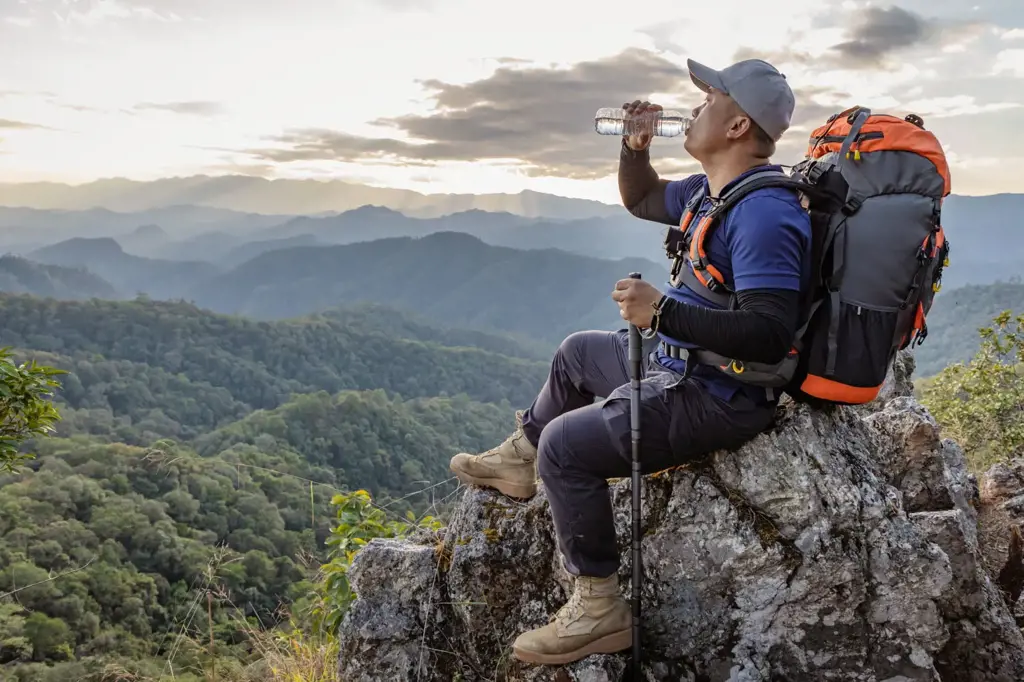
When embarking on a day hike, it is crucial to carry an adequate supply of water to stay properly hydrated throughout the journey. The amount of water you should bring in your summit pack depends on various factors, including the duration and difficulty of the hike, weather conditions, individual hydration needs, and availability of water sources along the trail.
As a general rule, it is recommended to carry at least 2 liters (or 64 ounces) of water per person for a full-day hike. This amount may vary depending on the factors mentioned above, so it's important to make adjustments accordingly. If the weather is hot and humid, or if you are hiking in high altitudes, you may need to increase your water intake to prevent dehydration. Additionally, if the hike is particularly strenuous or if you tend to sweat profusely, you should consider carrying extra water to compensate for fluid loss.
To estimate your individual hydration needs, consider your body weight, activity level, and environmental conditions. A common guideline is to drink half a liter (or 16 ounces) of water for every hour of moderate activity. However, this is just a starting point, as individual requirements can vary significantly. Factors such as age, sex, fitness level, and overall health also play a role in determining your hydration needs.
In addition to carrying an adequate supply of water, it's essential to plan your hydration strategy wisely. Here are some tips to help you stay hydrated during your day hike:
- Start hydrating before the hike: Drink plenty of water in the hours leading up to your hike to ensure your body is properly hydrated before you even hit the trail.
- Pack a water bladder or water bottles: Invest in a quality hydration system, such as a water bladder with a drinking tube or a sturdy water bottle. This will make it easy to sip water throughout the hike without having to stop and unpack your pack.
- Take breaks and drink regularly: Make it a habit to take short breaks every hour or so to rehydrate. Use these breaks as an opportunity to drink water and replenish your body's fluid levels.
- Monitor your urine color: Keep an eye on the color of your urine throughout the hike. Clear or light yellow urine indicates proper hydration, while dark yellow or amber-colored urine may be a sign of dehydration.
- Take advantage of natural water sources: If there are natural water sources along the trail, such as streams or lakes, you can reduce the amount of water you need to carry by using a water filter or purification tablets to make the water safe for consumption.
Remember, it's always better to have more water than you need rather than running the risk of becoming dehydrated. Carrying extra weight may be a small inconvenience compared to the potential consequences of dehydration, such as fatigue, dizziness, or even heatstroke.
In conclusion, when preparing for a day hike, it is important to carry an adequate supply of water to stay hydrated. Start with a minimum of 2 liters per person, and adjust this amount based on individual factors and the conditions of the hike. Follow the tips mentioned above to ensure you have enough water to keep you healthy and energized throughout your adventure.
Essential Items to Pack for a Calvary Maternity Stay: Your Complete Guide
You may want to see also

Are there any specific items that should be included in a summit pack for a winter hiking trip?
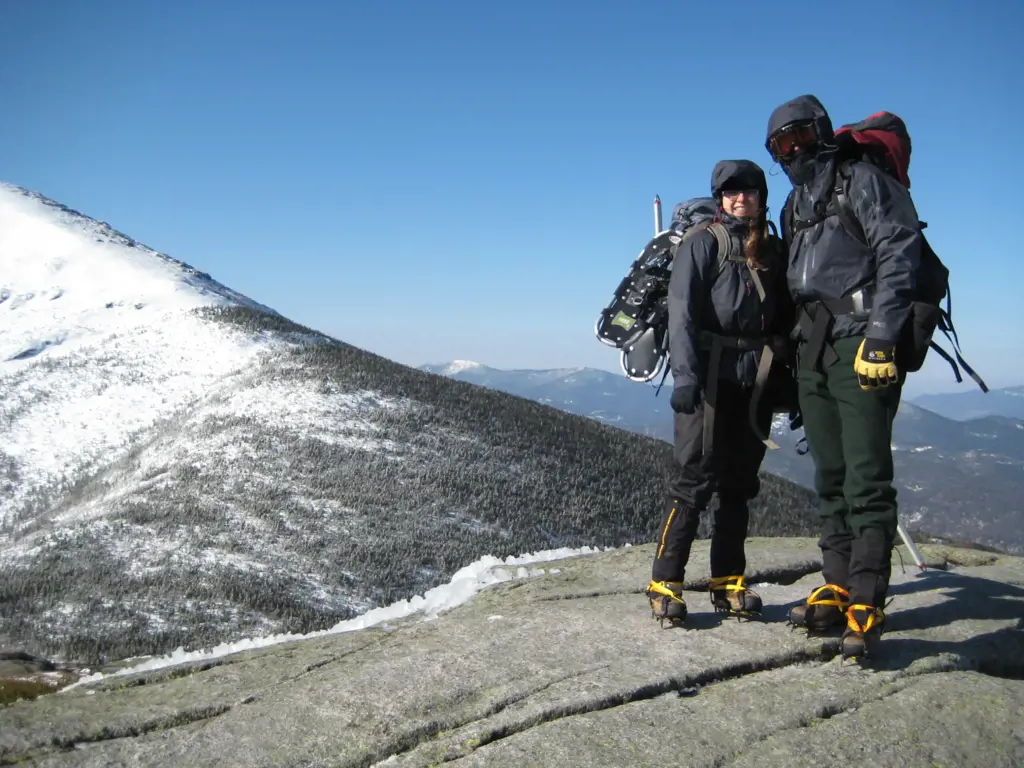
When planning a winter hiking trip, it is crucial to have the right gear to ensure your safety and comfort on the trail. One essential item that every winter hiker should have is a summit pack. A summit pack is a small backpack that you can easily carry with you when you leave your main backpack behind to reach the summit of a mountain. It allows you to travel light and quickly without sacrificing the necessary gear.
Here are some specific items that you should include in your summit pack for a winter hiking trip:
- Extra Layers: Winter weather can be unpredictable, and temperatures can drop rapidly. It is essential to carry extra layers of clothing like a fleece jacket, an insulated down jacket, and an extra pair of gloves or mittens to stay warm and dry.
- Hat and Neck Gaiter: A warm hat and a neck gaiter or scarf are essential to protect your extremities from the cold and prevent heat loss. Be sure to choose materials that provide good insulation and moisture-wicking capabilities.
- Hand and Foot Warmers: Hand and foot warmers are small packets that generate heat when exposed to air. These can be lifesavers in extremely cold conditions, providing instant warmth to your extremities and helping to prevent frostbite.
- Navigation Tools: In winter conditions, the trail can be covered with snow, making it difficult to follow. Bring a map and a compass to navigate your way safely. Additionally, consider carrying a GPS device to track your progress and ensure you're heading in the right direction.
- Headlamp: Winter days are shorter, and you may find yourself hiking in the dark, especially if you're aiming for a sunrise or sunset hike. A headlamp with a reliable battery source can help you navigate the trail and perform tasks in low-light conditions.
- Emergency Shelter: In case of an unexpected storm or injury, having a lightweight emergency shelter like a bivy sack or a space blanket can provide temporary protection from the elements. These shelters are compact and easy to pack, making them ideal for a summit pack.
- Food and Water: It is essential to stay hydrated and fueled during your hike. Pack high-energy snacks like trail mix, energy bars, and chocolate to keep your energy levels up. Carry a thermos or insulated water bottle to prevent your water from freezing.
- First Aid Kit: Accidents can happen even on shorter hikes, so it is crucial to pack a compact first aid kit with essential items like band-aids, adhesive tape, pain relievers, and emergency supplies.
- Multi-Tool: A multi-tool can come in handy for various tasks on the trail, such as repairing gear, cutting ropes, or opening cans. Choose a durable and compact tool with pliers, a knife, and a screwdriver.
Remember, the key to a successful winter hiking trip is to be prepared and have the right gear. Always check the weather forecast and trail conditions before heading out. Additionally, make sure you have the skills and knowledge necessary to navigate and handle winter conditions. Stay safe and enjoy the stunning winter landscapes!
The Ultimate Guide to Packing Food for a 5-Day Hike
You may want to see also

What should be considered when selecting a summit pack for a long-distance trek?
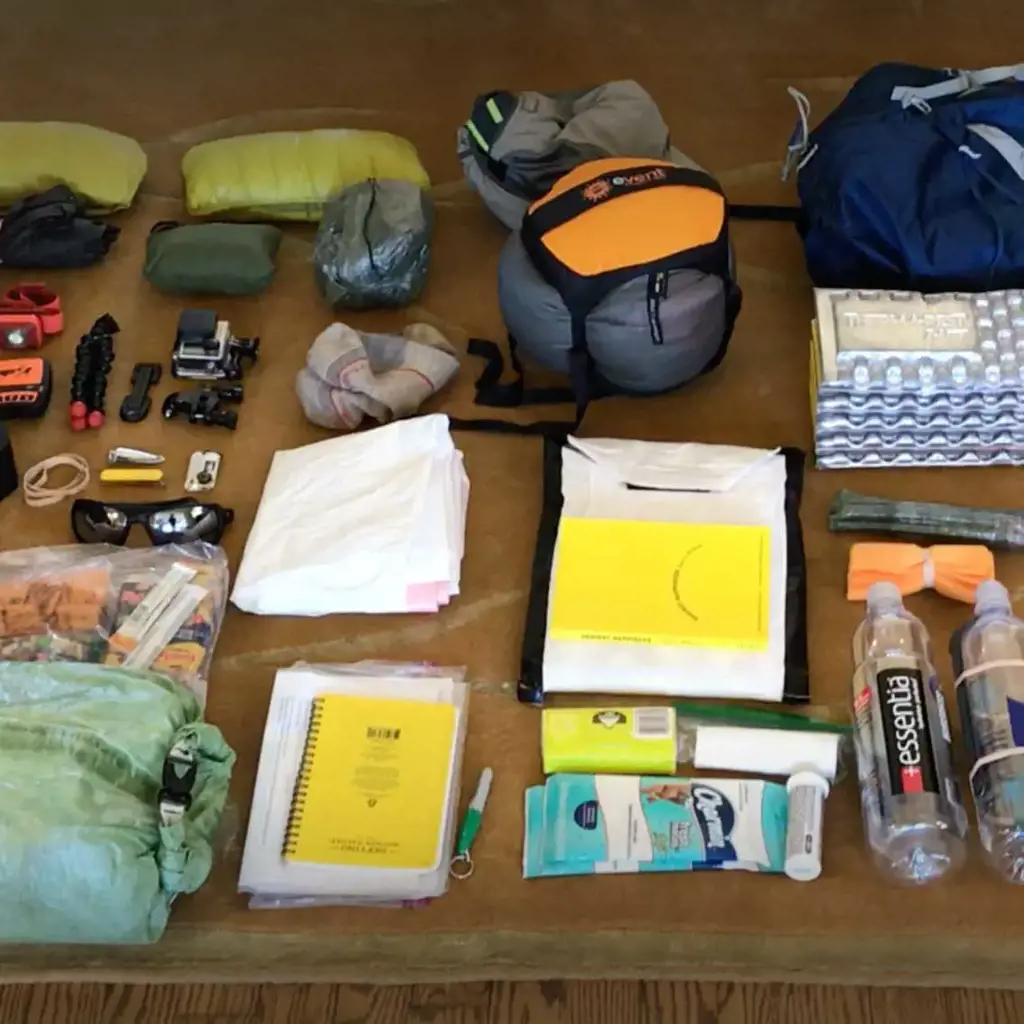
When embarking on a long-distance trek, having a reliable and efficient summit pack is crucial. A summit pack is a smaller backpack that is carried during summit attempts or daily excursions from base camps. Selecting the right summit pack can significantly enhance your overall trekking experience. Here are some factors to consider when choosing a summit pack for a long-distance trek.
Size and Capacity:
The size and capacity of the summit pack are important considerations. It should be large enough to hold essential items like extra clothing layers, a first aid kit, food, water, and other personal items, but not so large that it becomes cumbersome to carry. A pack with a volume of around 20-30 liters is typically suitable for most long-distance treks.
Weight:
One of the key factors for a long-distance trek is weight. The summit pack should be lightweight yet durable. Look for packs made from lightweight materials such as ripstop nylon or Dyneema. Additionally, minimize the weight of the pack itself by opting for packs that have lightweight frames or are frameless.
Comfort and Fit:
Since you'll be carrying the summit pack for extended periods, comfort and fit are essential. Look for packs with adjustable shoulder straps, a padded waist belt, and a sternum strap. These features will help distribute the weight evenly and prevent strain on your shoulders and back. It's also important to try on the pack before purchasing to ensure it fits your body well. Some outdoor stores even offer fitting services to help you find the right pack for your body type.
Accessibility and Organization:
A well-designed summit pack should have multiple compartments and pockets for easy organization of your gear. Look for packs with external mesh pockets for water bottles or quick-access items. Additionally, having a dedicated hydration bladder sleeve or external attachment points for trekking poles can be convenient features to consider.
Durability:
When trekking over long distances, you'll encounter various terrains and weather conditions. Thus, it's crucial to choose a summit pack that is durable and can withstand rugged environments. High-quality materials, reinforced stitching, and robust zippers are signs of a durable pack.
Weather Resistance:
Trekking often involves exposure to different weather conditions, including rain, snow, and sunshine. Opt for summit packs made from water-resistant materials to protect your gear from getting wet in case of unexpected rain showers. Some packs also come with a rain cover that can be used during heavy downpours.
Brand Reputation and Reviews:
Lastly, consider the reputation and reviews of the brand before making a purchase. Research online for reviews and feedback from other hikers who have used the pack on long-distance treks. This will give you insights into the pack's performance and reliability.
To illustrate these considerations, let's look at an example. Imagine you're planning a multi-day trek in the Himalayas. Considering the remote and challenging environment, you decide to invest in a summit pack that meets all the criteria discussed. You choose a 25-liter pack made from lightweight ripstop nylon with adjustable shoulder straps, a padded waist belt, and a sternum strap. The pack has multiple compartments for easy organization and external mesh pockets for water bottles. It is also highly durable with reinforced stitching and robust zippers. Additionally, the pack is made from water-resistant materials and comes with a rain cover for extra protection. After reading positive reviews from experienced trekkers, you confidently purchase the pack and embark on your long-distance trek, knowing that you have made a well-informed choice.
In conclusion, selecting the right summit pack is essential for a long-distance trek. Consider factors such as size and capacity, weight, comfort and fit, accessibility and organization, durability, weather resistance, and brand reputation. By carefully evaluating these factors and choosing a pack that meets your specific needs, you can ensure a more enjoyable and successful trekking experience.
Essential Items to Pack for RAGBRAI: A Comprehensive Guide
You may want to see also

Are there any recommended safety items that should always be included in a summit pack, regardless of the hiking conditions?
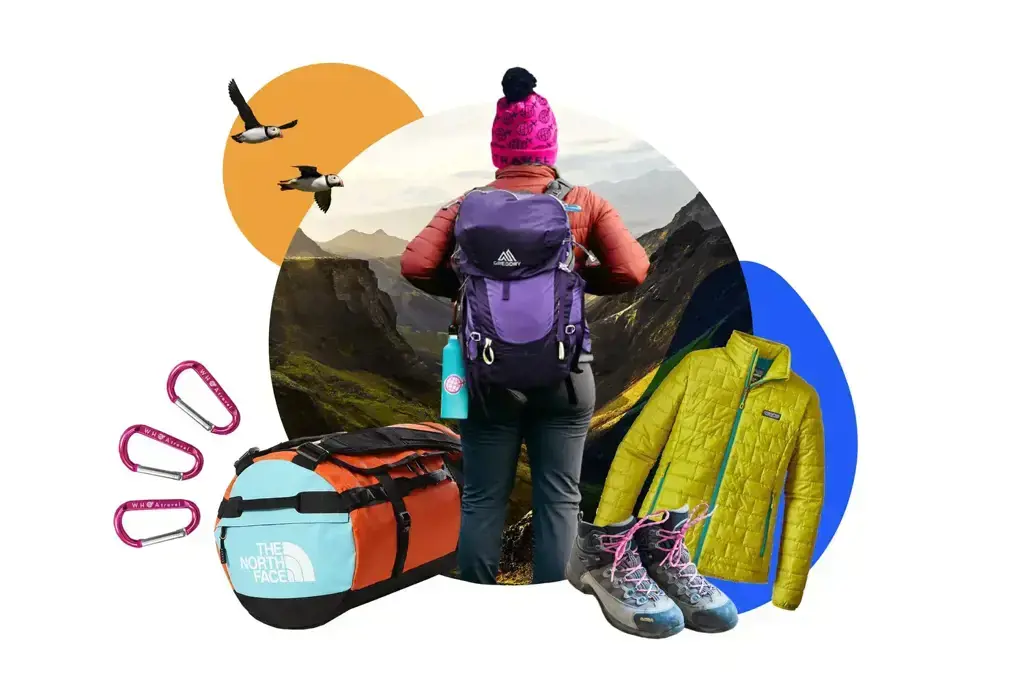
When preparing for a summit hike, it is very important to consider safety as a top priority. Regardless of the hiking conditions, there are a few recommended safety items that should always be included in your summit pack. These items can help ensure your well-being and increase your chances of successfully completing your hike. In this article, we will discuss some essential safety items that you should always carry with you on a summit hike.
- Navigation Tools: One of the most important safety items to include in your summit pack is navigation tools. These tools can help you stay on track and navigate your way, especially in unfamiliar terrain or adverse weather conditions. A compass, map, and GPS device are some essential navigation tools that can help you find your bearings and avoid getting lost.
- Communication Device: Carrying a communication device, such as a satellite phone or a two-way radio, is crucial for emergencies. In case of an unexpected situation, you can use these devices to call for help and inform authorities or your loved ones about your whereabouts. Ensure that the communication device is fully charged and in good working condition before heading out on the hike.
- First Aid Kit: Accidents and injuries can happen during a summit hike, so it is imperative to carry a well-stocked first aid kit. The first aid kit should include essentials such as bandages, antiseptic wipes, blister treatment, pain relievers, and any necessary prescription medications. Familiarize yourself with basic first aid techniques to be prepared for any medical emergencies that may arise.
- Emergency Shelter: Even if you are planning a day hike, it is always a good idea to include emergency shelter in your summit pack. This can be a lightweight bivvy bag or an emergency blanket that can provide protection from harsh weather conditions or unforeseen circumstances. It is better to be prepared and have a shelter option, even if you don't anticipate needing it.
- Warm Clothing: In mountainous terrains, the weather can change dramatically and become colder as you ascend. It is essential to pack warm clothing, including a waterproof jacket, hat, gloves, and extra layers. Even if the weather seems pleasant at the start, conditions can deteriorate quickly, and being underprepared can lead to hypothermia or frostbite.
- Headlamp and Extra Batteries: A headlamp is a valuable safety item that should always be included in your summit pack. It can help you navigate in low-light or dark conditions, such as early morning or late evening hikes. Make sure to carry spare batteries to ensure your headlamp remains functional throughout the hike.
- Food and Water: It is crucial to carry an ample supply of food and water, even on shorter hikes. Summit hikes can be physically demanding, and dehydration and low energy levels can hamper your progress and increase the risk of accidents. Pack high-energy snacks, such as nuts, energy bars, and dried fruit, along with enough water to keep yourself hydrated throughout the hike.
- Emergency Whistle: An emergency whistle is a small, lightweight item that can be a lifesaver in dire situations. Three short bursts on a whistle are internationally recognized as a distress signal. If you find yourself in need of help, blowing the whistle can attract attention and aid rescuers in locating you quickly.
In conclusion, regardless of the hiking conditions, it is important to include certain safety items in your summit pack. Navigation tools, communication devices, first aid kits, emergency shelter, warm clothing, headlamps, food, water, and emergency whistles are crucial items that can help ensure your safety during a summit hike. It is always better to be overprepared rather than underprepared when it comes to safety in the outdoors.
Essential Items to Pack for a Trip to India
You may want to see also
Frequently asked questions
When packing your summit pack, it is important to bring essential items that will help you stay safe and prepared during your climb. Some essential items to carry include extra layers of clothing, such as a warm jacket and hat, to protect yourself from changes in temperature or unexpected weather conditions. You should also carry enough water to stay hydrated throughout your climb, as well as high-energy snacks to keep you fueled. Additionally, it is recommended to bring a first aid kit, a headlamp or flashlight, a map and compass, sunscreen, and a multi-tool or knife.
While wearing a helmet may not be necessary for all types of climbs, it is generally recommended to bring one in your summit pack for added safety. Wearing a helmet can protect you from falling rocks, ice, or other debris that may be present on the route. Even if the climb is considered to be relatively safe, it is always better to be prepared and have the necessary equipment to mitigate any potential risks.
Bringing a camera in your summit pack is a personal choice and depends on your preferences. Some climbers enjoy documenting their journey and capturing the beautiful views from the summit. However, it is important to keep in mind that carrying a camera adds extra weight to your pack and can be a potential distraction during the climb. If you do decide to bring a camera, consider using a lightweight and compact one to minimize the added weight and ensure it doesn't hinder your movements.
The weight of your summit pack will vary depending on the specific climb and the duration of your trip. In general, it is recommended to aim for a pack that weighs no more than 10-15% of your body weight. This will help ensure that you can comfortably carry the pack during the climb without feeling overly burdened or fatigued. However, it is important to prioritize safety and bring necessary items, even if it means slightly exceeding the recommended weight limit.







